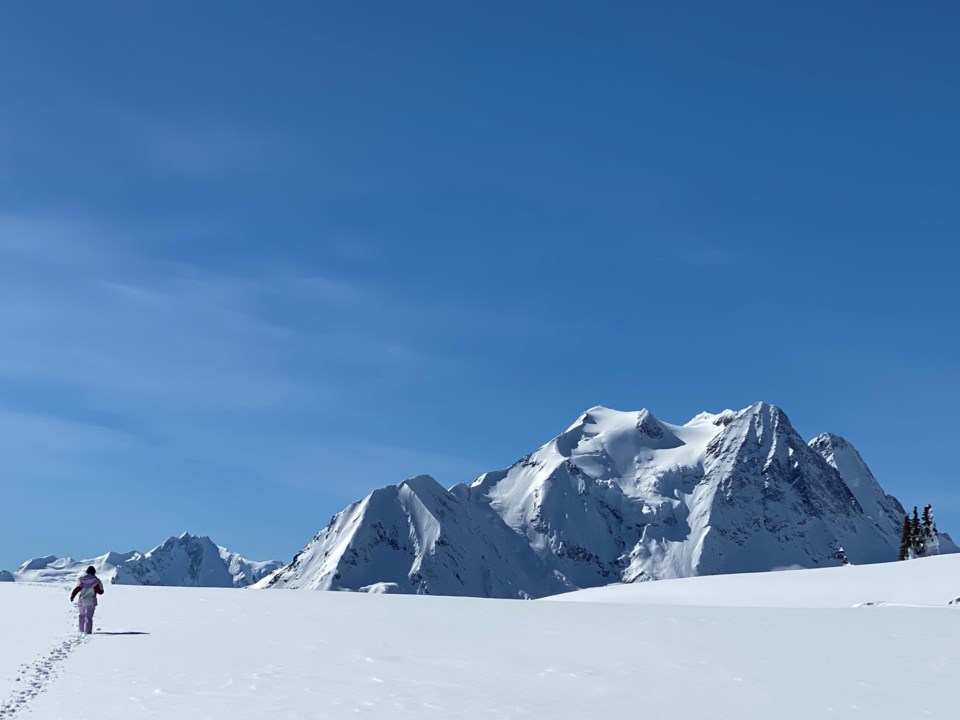Here’s how it usually happens: The helicopter pulls away from the ridge, wrapping you in an envelope of swirling crystals. As the cloud dissipates and sound drifts off like a wind dying in the treetops, a weight is lifted from your life. Maybe you don’t feel it at first because the void is instantly filled by what you see—mountains on every horizon; nothing and no one in sight. But you feel it after that first run. The one where you drop hundreds of vertical metres through snow so light and deep it pours up over your shoulders like water. It’s the best skiing you’ve done in a lifetime of great skiing.
It’s what skiers dream about, and, if they’ve booked it, look forward to all season. But what happens when the weather forecast is set to eat that dream alive? Our recent big snow cycle had me hungrily looking forward to an assignment at Canadian Mountain Holidays’ newest destination, CMH Purcell, when I looked a little farther ahead to see a preternatural temperature anomaly—a March warm-up of double-digits above seasonal norms and overnight freezing levels above 3,000 metres—coinciding with my dates. I crossed my fingers but the forecast was accurate and precise; between the massive snow-shedding expected in the mountains and the malign metamorphosis of powder to pig-snot, this did not look good. The weather would be glorious but the snow not so much. Would it shut us down?
Not even.
Man has always wanted to fly, and when he invented skiing—lauded as the closest thing to flying without leaving the Earth—he came damn close. It took immigrant Swiss mountain guide Hans Gmoser’s vision of soaring through a mountain wilderness on wings to experience true freedom on skis to link these ideas. In 1965, Gmoser ran the world’s first heli-skiing week in the Bugaboos, a sub-range of the Purcells whose name will forever be synonymous with an experience that participants immediately found transcendent. Gmoser’s CMH would birth an industry and put B.C. on the global ski map as a powder paradise. Another pioneer of the time, Rudi Gertsch, a Swiss immigrant who arrived in Banff in 1966 to land a job as a climbing guide with the CMH crew, was quickly drawn into Gmoser’s heli-skiing passion. He learned the ropes of a nascent business during its discovery years and struck out on his own in 1974 with a day-ski operation out of Golden from which, unlike a remote lodge-based operation, he could drive home each night. Purcell Heliskiing became an iconic family business, with scion Jeff—who first heli-skied at age three—as lead guide. But what goes around comes around, and in 2021 CMH welcomed Purcell into the fold of its many heli-ski operations as the only day-skiing destination.
The Purcells feature dramatic, smooth-sided stone towers punching up from wide alpine bowls; their neighbours, the Selkirks, do the same on steroids. With an abundance of snow and over 2,000 sq. km (~495,000 acres) of terrain, a 10 to 15-minute flight transports skiers to a vast, pristine winter landscape. More than 250 named runs cover every conceivable type of terrain—wide-open glaciers, high-alpine bowls, gladed subalpine, open cutblocks, and steep trees. Scattered throughout the tenure are hand-built safety cabins used for lunch stops, each of which features a spectacular view. You can enjoy soup and sandwiches on a porch facing some of the runs you’ve just skied. From newbies to long-timers looking for something new, CMH is shilling its Purcell operation as “an exciting new menu item.”
Exciting and practical. Purcell also has a heli-pad at Kicking Horse Mountain Resort. It’s still day skiing, but if you’re on a multi-day program (as we were—any group can craft its own) you can heli-ski in/out of your accommodations and also have the impressive inbounds skiing at Kicking Horse Mountain Resort at your disposal on down days. Bonus: a day at Purcell includes unlimited runs. Meaning if you end up exceeding the guaranteed vertical, there’s no extra charge. Say what?
Even with the decidedly un-wintery weather outlook, I shouldn’t have been surprised at the positive outcome. With heli-skiing, expectations are so often exceeded they’re almost irrelevant. And with the guides’ world of experience and eye on aspect, elevation, snowpack, wildlife movement and more, somehow, despite temperatures of 15 C and higher in the alpine, we skied powder of various depths on each of three days—the last being the best. The group of first-timers I was with were all blown away, and we engaged in as much head-shaking over our good fortune as high-fiving. And I realized something: in sketchy conditions, in being able to hopscotch around hazards from one mellow spot to another, helicopters are the safest way to avoid traversing dangerous terrain in the backcountry. Purcell proved a great place to do just that in otherwise crazy heat and manky snow. Even the local touring contingent was using helicopters to be deposited on high-elevation, low-angle, north-facing glaciers.
Ultimately, when the heli pulled away from the landing zones and left us squinting through swirling crystals, we still saw the same majestic mountains we expected, skied better snow than we could have imagined, and came away with Cheshire-cat smiles, sore legs and that warm glow of a ski-dream come true.
Leslie Anthony is a Whistler-based author, editor, biologist and bon vivant who has never met a mountain he didn’t like.




